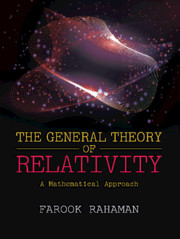Book contents
- Frontmatter
- Dedication
- Contents
- List of Figures
- List of Tables
- Preface
- Acknowledgments
- Chapter 1 Tensor Calculus — A Brief Overview
- Chapter 2 Geodesic
- Chapter 3 Einstein Field Equations
- Chapter 4 Linearized Gravity
- Chapter 5 Lie Derivatives and Killing’s Equation
- Chapter 6 Spacetimes of Spherically Symmetric Distribution of Matter and Black Holes
- Chapter 7 Particle and Photon Orbits in the Schwarzschild Spacetime
- Chapter 8 Causal Structure of Spacetime
- Chapter 9 Exact Solutions of Einstein Equations and Their Causal Structures
- Chapter 10 Rotating Black Holes
- Chapter 11 Elementary Cosmology
- Chapter 12 Elementary Astrophysics
- Appendix A Extrinsic Curvature or Second Fundamental Form
- Appendix B Lagrangian Formulation of General Relativity
- Appendix C 3+1 Decomposition
- Bibliography
- Index
Appendix A - Extrinsic Curvature or Second Fundamental Form
Published online by Cambridge University Press: 24 March 2021
- Frontmatter
- Dedication
- Contents
- List of Figures
- List of Tables
- Preface
- Acknowledgments
- Chapter 1 Tensor Calculus — A Brief Overview
- Chapter 2 Geodesic
- Chapter 3 Einstein Field Equations
- Chapter 4 Linearized Gravity
- Chapter 5 Lie Derivatives and Killing’s Equation
- Chapter 6 Spacetimes of Spherically Symmetric Distribution of Matter and Black Holes
- Chapter 7 Particle and Photon Orbits in the Schwarzschild Spacetime
- Chapter 8 Causal Structure of Spacetime
- Chapter 9 Exact Solutions of Einstein Equations and Their Causal Structures
- Chapter 10 Rotating Black Holes
- Chapter 11 Elementary Cosmology
- Chapter 12 Elementary Astrophysics
- Appendix A Extrinsic Curvature or Second Fundamental Form
- Appendix B Lagrangian Formulation of General Relativity
- Appendix C 3+1 Decomposition
- Bibliography
- Index
Summary
A hypersurface Σ is a three-dimensional sub-manifold of a four-dimensional spacetime manifold M. The hypersurface may be time-like, space-like or null.
Let us consider that xμ (μ = 1; 2; 3; 4) are the coordinate of the four-dimensional spacetime, and ya(a = 1, 2, 3) are the inherent coordinates of the hypersurface.
The parametric equation of the hypersurface is
The three basis vectors provide the tangent vectors to Σ as
These basis vectors provide the induced metric or first fundamental form of the hypersurface by the following scalar product
[Actually, the elementary distance “ds” between two neighboring points in Σ (which are, therefore, also in M) is given by
where is the induced metric tensor in the hypersurface Σ.]
A unit normal nα can be defined if the hypersurface is not null.
Let us consider the surface Σ, defined by the Eq. (A1), which can be written in the form
Hence, the unit normal vector nμ is defined as
Here, and
Note that unit normal is defined when Σ is non-null as for null surface gμ𝜈 f,μf,𝜈 = 0.
The extrinsic curvature or second fundamental form of the hypersurface Σ is defined by
Extrinsic curvature is symmetric tensor, i.e., kab = kba.
Another form
Here, Ln stands for Lie Derivative.
trace of the extrinsic curvature.
Result
(i) If k > 0, then the hypersurface is convex
(ii) If k < 0, then the hypersurface is concave
hab is purely the inherent property of a hypersurface geometry, whereas kab is concerned with extrinsic aspects.
Remember
where hab is the inverse of the induced metric.
It is possible that any arbitrary tensor Tαβ can be projected down to the hypersurface with nonzero tangential components. The quantity that effects the projection is
One can make a 3 + 1 split of the spacetime M in a slightly different manner as follows (see Appendix C for more details):
Let us consider an arbitrary scalar field t(xα) such that t = constant describes a family of nonintersecting space-like hypersurfaces Σt.
- Type
- Chapter
- Information
- The General Theory of RelativityA Mathematical Approach, pp. 379 - 382Publisher: Cambridge University PressPrint publication year: 2021



